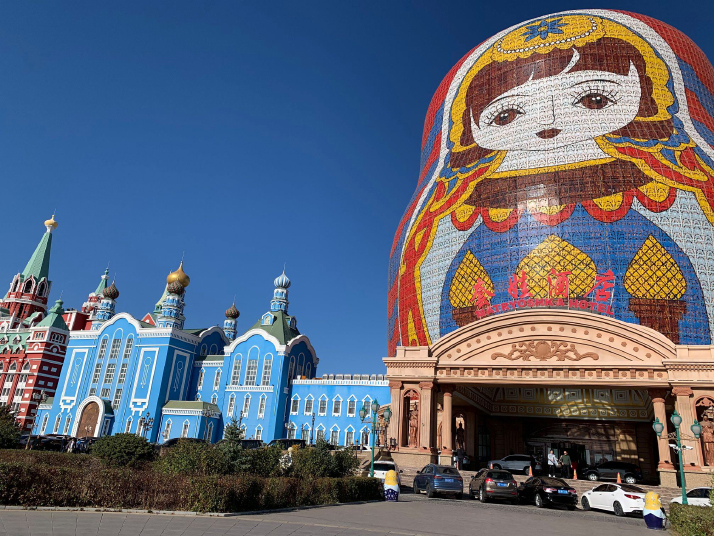| Lifestyle |
| One Steppe From Russia | |
| An American living in Beijing shares experience on visiting the China-Russia border | |
|
|
 The Matryoshka Hotel in Manzhouli, north China's Inner Mongolia Autonomous Region (PAMELA TOBEY)
Upon my first sighting of the steppes of north China's Inner Mongolia Autonomous Region near the China-Russia border, my mind began playing the refrain from the Broadway musical Oklahoma: "Oklahoma, where the wind comes sweepin' down the plain." Although the plains here were not as flat, the wind was blowing strongly. I was struck by the resemblance to the wide open windswept prairies of the western part of my home state of Texas and much of the adjoining state of Oklahoma. Instead of just seeing horses and cattle in the fields as I would back home, I noticed sheep added to the livestock mix in Inner Mongolia. The herdsmen looked similar to those in Texas, deftly riding their swift horses to round up the milling livestock and guide them to a new field. After landing at Haila'er, my husband, a friend and I headed to the Hulun Buir Nationality Museum to learn more about the local culture. Viewing old photos of the nomadic Mongolians and displays of their traditional clothing and possessions, I was struck by their resemblance to Native Americans, down to the decorative styling and leather work. And though the main housing structures used in this area have been round yurts for centuries, the Mongolians also had a more portable conical structure, called teepee in the U.S. They are very similar to those used by the nomadic tribes of the American Great Plains. To get a more "authentic" experience, we then went to a Mongolian attraction. Sculptures of ancient Mongolian warriors and traditional mythic beasts lined the path to the yurt complex. We found a large aobao, a tall stacking of stones in a circle that is decorated with blue ribbons that match the sky above and small colorful banners. It is used in a traditional festive Buddhist ritual during the summer. We decided to experience a bit of Chinese history by traveling on one of the classic old green trains to get to our next stop of Manzhouli. Although China's sleek high-speed trains get people to their destinations quickly and efficiently, there is something quite pleasant in riding more slowly and paying attention to the countryside. Once there, I felt transported back to my early travels in the Soviet Union and later in Russia. The town combines the Baroque and neoclassical architecture that fills much of Odessa and St. Petersburg in Russia, those of rural wooden structures framed in colorful lacy wood trim, and clusters of colorful onion domes like those seen atop St. Basil's Cathedral in Red Square in Moscow. The hotel we chose was created around the Russian theme of traditional nesting dolls, so of course it was called the Matryoshka Hotel. You could see it from a distance, the main building being a 17-story Matryoshka. Inside our room, the nesting doll decor was on everything from the chair cushions and rugs to the Matryoshka-shaped tea set and light fixtures—a fun fantasy land. Downtown, each sign was a combination of Mongolian, Chinese and Cyrillic lettering. Everywhere we went, we found that most of the Chinese residents could speak at least a little Russian. Our travels would not have been complete without a trip to the China-Russia border. Foreigners were not allowed to enter the actual border area, so we climbed to a second-floor observation platform from where we could see the large gate marking China and a smaller one in the distance marking Russia. We could also see a small Russian village, and on the Chinese side, shops full of goods imported from Russia. Manzhouli and Haila'er are an interesting melding of Chinese and Russian culture. The topography is the same, whether it is called the steppes of Siberia, the grasslands of Inner Mongolia or the plains of Oklahoma. To a native of the American Southwest, the wide open spaces and bright blue skies felt like home. The author is an American living in Beijing Copyedited by Sudeshna Sarkar Comments to dingying@bjreview.com |
|
||||||||||||||||||||||||||||
|
